Santa Cruz de Tenerife is the capital and largest city of Tenerife. It's also the capital city of the Canary Islands, together with Las Palmas.
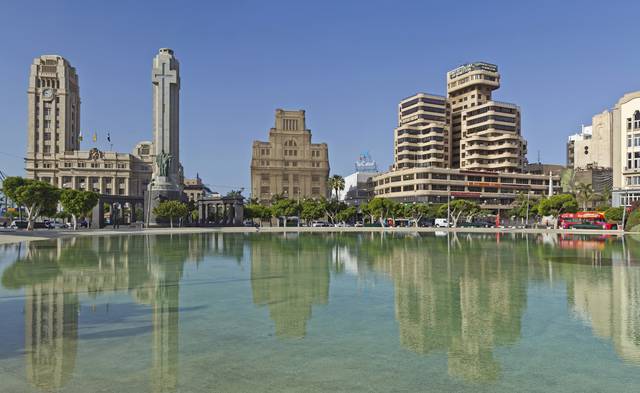
Santa Cruz de Tenerife is at the eastern tip of the island of Tenerife, the largest of the Canary Island chain. The municipal borough covers an area of 150.56 square kilometres and it is divided into two areas: the Anaga Massif and the southern ramp formed by the lava flows that run down from the Acentejo peak to the coast. The city's population was 223,347 in 2005.
From the beginning, the economic nucleus of the city centred on the port. The first wharf, constructed in 1548, was by the beach of Añazo, later destroyed in a storm. The bay of Santa Cruz was appreciated by navigators due to its natural advantages and that turned it into a food supply centre for the ships that sailed for the New World.
At the end of the 15th century a heterogeneous society began to form. The first settlements were near the castle of San Cristóbal, a fortification that protected the small town. New defensive castles were constructed along the coastal areas because the people of Santa Cruz had to defend themselves from frequent attacks by privateers and berberiscos pirates, Gallic and English. It fell to the British Navy, commanded by Admiral Nelson, on 25 July 1797.
One of the capitals of the Canary Islands, Santa Cruz de Tenerife is a modern city with a rich colonial history. It has a variety of historic and modern architecture, parks, and museums for travellers to discover.
- Church of the Immaculate Conception.
- Church of St. Francis of Assisi, Calle Villalba Hervás. The second most important church in the city, after the Church of the Conception, completed in 1680 and notable for the large number of artworks inside. It is a good example of Baroque architecture on the Canary Islands.
Church of the Immaculate Conception.
Church of St. Francis of Assisi, Calle Villalba Hervás. The second most important church in the city, after the Church of the Conception, completed in 1680 and notable for the large number of artworks inside. It is a good example of Baroque architecture on the Canary Islands.
- Auditorio de Tenerife, Avenida de la Constitución. Auditorium designed by architect Santiago Calatrava, on the shore of the Atlantic Ocean. Constructed between 1997 and 2003, the design is framed within the tenets of late-modern architecture of the late 20th century, and regarded as one of the finest modern buildings on the archipelago. It has been featured on post stamps and commemorative coins of 5 euros. The auditorium is the most recognizable and most photographed structure in the city. The main hall has capacity for 1616 spectators with a 16.5 m wide stage.
- Santa Cruz Towers.
Auditorio de Tenerife, Avenida de la Constitución. Auditorium designed by architect Santiago Calatrava, on the shore of the Atlantic Ocean. Constructed between 1997 and 2003, the design is framed within the tenets of late-modern architecture of the late 20th century, and regarded as one of the finest modern buildings on the archipelago. It has been featured on post stamps and commemorative coins of 5 euros. The auditorium is the most recognizable and most photographed structure in the city. The main hall has capacity for 1616 spectators with a 16.5 m wide stage.
Santa Cruz Towers.
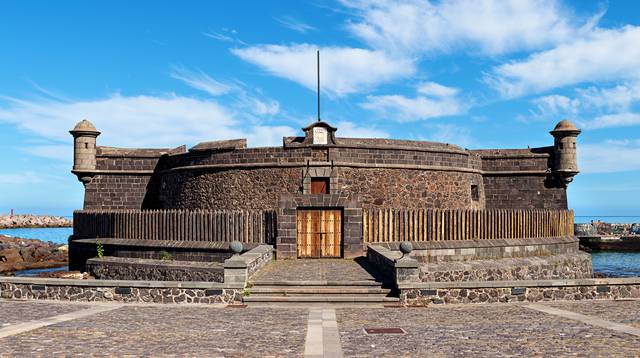
- Castle of St John the Baptist.
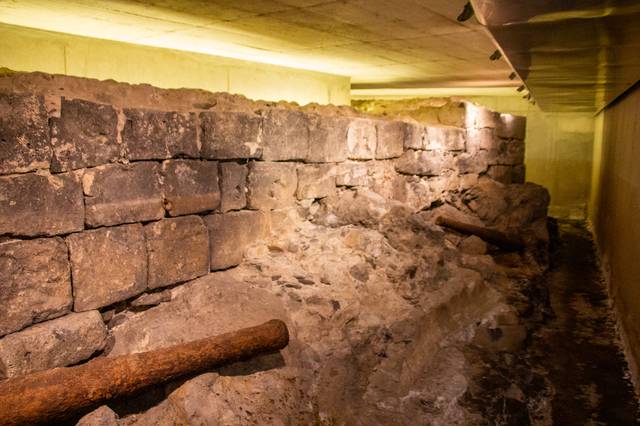
- Spain Square. 24/7. The largest square in the city, with an artificial lake fountain by Swiss architects Herzog & de Meuron in its centre. It was constructed at the original location of the Castle of San Cristóbal in 1929. Free.
- Castle of San Cristóbal, Plaza de España, +34 922 28 56 05. M-Sa 10:00-18:00. The first fortification of significance on Tenerife, intended as defensive stronghold for the Santa Cruz Bay, constructed between 1575 and 1577 to protect the city against pirates. From the 20th century it lost its significance as defensive structure and was demolished in 1929 to make space for the Plaza de España, which was built over the foundations of the castle. When the Plaza was remodelled in 2006, remains of the castle were discovered and a tunnel was constructed to make them accessible to the general public. They can be visited, along with a small visitor centre.
Castle of St John the Baptist.
Spain Square. 24/7. The largest square in the city, with an artificial lake fountain by Swiss architects Herzog & de Meuron in its centre. It was constructed at the original location of the [[Santa Cruz de Tenerife#Q2073174|Castle of San Cristóbal]] in 1929. Free.
Castle of San Cristóbal, Plaza de España, +34 922 28 56 05. M-Sa 10:00-18:00. The first fortification of significance on Tenerife, intended as defensive stronghold for the Santa Cruz Bay, constructed between 1575 and 1577 to protect the city against pirates. From the 20th century it lost its significance as defensive structure and was demolished in 1929 to make space for the [[Santa Cruz de Tenerife#Q1772649|Plaza de España]], which was built over the foundations of the castle. When the Plaza was remodelled in 2006, remains of the castle were discovered and a tunnel was constructed to make them accessible to the general public. They can be visited, along with a small visitor centre.
- Museum of Nature and Archeology, Calle Fuente Morales, +34 922 53 58 16. Tu-Sa 09:00-20:00, Su-M 10:00-17:00. Considered one of the best repositories of Pre-Castilian objects on the Canary Islands, with significant paleontological, botanical, entomological, and marine and terrestrial vertebrate collections. It holds the largest collection of Guanche objects, for which it is internationally best known. It is widely thought of as the best museum of the Canary Islands. €5.
- Canarian Military History Museum, Calle San Isidro. Military history museum in the north of the city, housed in Fort Almeyda, a fortress built in 1859 to house artillery pieces to protect the vulnerable side of Santa Cruz against English invaders threatening the coast since 1797 under the command of Rear Admiral Nelson. It was designed as a compensation for the lack of defenses on the northern and western parts of the city, and protect the entrance of the Almeida ravine.
- Photo Center Tenerife Island, +34 922 53 58 16. Opened in 1989, the centre owns a studio and photo lab, a conference room, and specialized library with more than 3500 books and files.
- Museum of Fine Arts. Museum founded in 1840 when the city took the initiative to store flags from the Battle of Cape St Vincent in a permanent location. The classic style building was established in 1929 by architect Eladio Laredo, and decorated with 10 different busts. The museum has 14 rooms, with collections ranging from 16th century Flemish to 20th century paintings, along with numerous sculptures and crafts. The "Tríptico de Nava y Grimón" by the Flemish painter Pieter Coecke is one of the most important pieces on display. There are also works from Canarian painters Juan de Miranda, Afonso Gaspar de Quevedo, Jose Rivera, and Cristóbal Hernandez de Quintana.
- Tenerife Space of Arts, Avenida de San Sebastián 8. Cultural space and modern arts museum opened in 2008, with a permanent exhibition of the works of Óscar Domínguez. €7.
Museum of Nature and Archeology, Calle Fuente Morales, +34 922 53 58 16. Tu-Sa 09:00-20:00, Su-M 10:00-17:00. Considered one of the best repositories of Pre-Castilian objects on the Canary Islands, with significant paleontological, botanical, entomological, and marine and terrestrial vertebrate collections. It holds the largest collection of Guanche objects, for which it is internationally best known. It is widely thought of as the best museum of the [[Canary Islands]]. €5.
Canarian Military History Museum, Calle San Isidro. Military history museum in the north of the city, housed in Fort Almeyda, a fortress built in 1859 to house artillery pieces to protect the vulnerable side of Santa Cruz against English invaders threatening the coast since 1797 under the command of Rear Admiral Nelson. It was designed as a compensation for the lack of defenses on the northern and western parts of the city, and protect the entrance of the Almeida ravine.
Photo Center Tenerife Island, +34 922 53 58 16. Opened in 1989, the centre owns a studio and photo lab, a conference room, and specialized library with more than 3500 books and files.
Museum of Fine Arts. Museum founded in 1840 when the city took the initiative to store flags from the Battle of Cape St Vincent in a permanent location. The classic style building was established in 1929 by architect Eladio Laredo, and decorated with 10 different busts. The museum has 14 rooms, with collections ranging from 16th century [[Flanders|Flemish]] to 20th century paintings, along with numerous sculptures and crafts. The "Tríptico de Nava y Grimón" by the Flemish painter Pieter Coecke is one of the most important pieces on display. There are also works from Canarian painters Juan de Miranda, Afonso Gaspar de Quevedo, Jose Rivera, and Cristóbal Hernandez de Quintana.
Tenerife Space of Arts, Avenida de San Sebastián 8. Cultural space and modern arts museum opened in 2008, with a permanent exhibition of the works of Óscar Domínguez. €7.
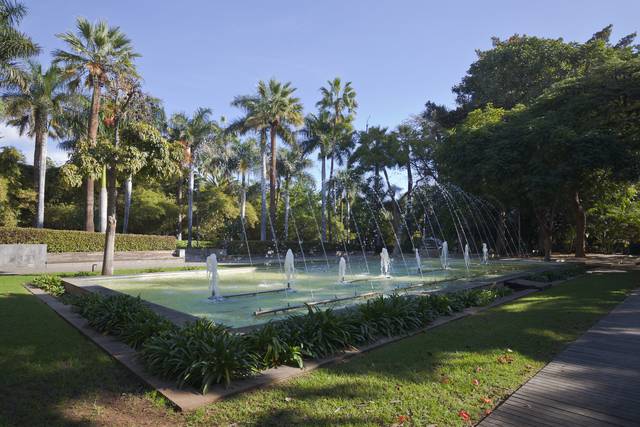
- García Sanabria Park, Rambla de Santa Cruz. 24/7. Public park inaugurated in 1926, laid out as a large garden with fountains and architecture. It is the largest urban park in the Canarias with an area of 67 230 m². The most important eye catcher is the park's floral clock, manufactured in Switzerland and gifted to Tenerife by the Consul of Denmark in 1958. Free.
-apdtu.medium.jpg)
- Palmetum, Avenida de la Constitución. Botanical garden with an area of 120 000 m² specialized in palms, set on an artificial hill overlooking the ocean. The garden includes a large system of streams, ponds, and waterfalls, as well as a museum dedicated to palms and a display shade house. Curiously, the botanical garden was built on a former landfill that was capped over in 1995, and opened to the public in 2014. It has over 600 species of palms on display, specializing in those native to tropical islands from around the world. The garden is an example of ecological botany, and is maintained without the use of pesticides or artificial fertilizers. Don't forget to pick up a map at the entrance for . Adults, children, under 2 years old free.
- Parque Taoro, Calle Taoro 27. 24/7. Park with fountains, waterfalls, and plenty of benches to take a rest in the shade while exploring Santa Cruz. Nice to have a quick stroll around. Free.
García Sanabria Park, Rambla de Santa Cruz. 24/7. Public park inaugurated in 1926, laid out as a large garden with fountains and architecture. It is the largest urban park in the Canarias with an area of 67 230 m². The most important eye catcher is the park's floral clock, manufactured in [[Switzerland]] and gifted to Tenerife by the Consul of [[Denmark]] in 1958. Free.
Palmetum, Avenida de la Constitución. Botanical garden with an area of 120 000 m² specialized in palms, set on an artificial hill overlooking the ocean. The garden includes a large system of streams, ponds, and waterfalls, as well as a museum dedicated to palms and a display shade house. Curiously, the botanical garden was built on a former landfill that was capped over in 1995, and opened to the public in 2014. It has over 600 species of palms on display, specializing in those native to tropical islands from around the world. The garden is an example of ecological botany, and is maintained without the use of pesticides or artificial fertilizers. Don't forget to pick up a map at the entrance for . Adults, children, under 2 years old free.
Parque Taoro, Calle Taoro 27. 24/7. Park with fountains, waterfalls, and plenty of benches to take a rest in the shade while exploring Santa Cruz. Nice to have a quick stroll around. Free.
There are a number of museums. A good history museum is five minutes' walk from the bus station, where Bus 14 stops. An art gallery in town and a small planetarium/science centre on the way to La Laguna (Bus 14 passes it). A Bono bus card not only entitles you to cheap travel on TITSA buses, but also cut-rate museum entrance. Large Sunday market near the bus station.
- Carnival of Santa Cruz de Tenerife. Annually in February. The carnival is the second biggest event of its kind (after the Rio de Janeiro Carneval). The historical event is held every February, and attracts around a million of visitors.
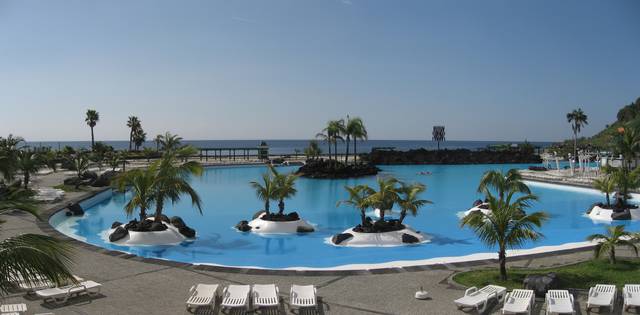
- Parque Marítimo César Manrique, c/ Artistica Union el Cabo 5 (Edif Buena Vista, +34 922 22 93 68. 10:00-19:00 daily. Water park designed by architect César Manrique, covering an area of 22 000 m², and aims to recreate a natural environment with volcanic rocks, palm trees, and ornamental plants. It has pools with sea water, artificial waterfalls, hot spring jacuzzi, and a small artificial beach. There are also sports facilities and a gym. Warning: there are no lockers to store valuables left unattended while swimming, and pickpockets roam around the park. Don't bring valuables into the park, and only bring the minimum amount of money necessary. Adults, children and seniors.
Carnival of Santa Cruz de Tenerife. Annually in February. The carnival is the second biggest event of its kind (after the [[Rio de Janeiro]] Carneval). The historical event is held every February, and attracts around a million of visitors.
Parque Marítimo César Manrique, c/ Artistica Union el Cabo 5 (Edif Buena Vista, +34 922 22 93 68. 10:00-19:00 daily. Water park designed by architect César Manrique, covering an area of 22 000 m², and aims to recreate a natural environment with volcanic rocks, palm trees, and ornamental plants. It has pools with sea water, artificial waterfalls, hot spring jacuzzi, and a small artificial beach. There are also sports facilities and a gym. Warning: there are no lockers to store valuables left unattended while swimming, and pickpockets roam around the park. Don't bring valuables into the park, and only bring the minimum amount of money necessary. Adults, children and seniors.
There are two El Corte Ingles department stores selling pretty much everything, as well as various shopping complexes on the outskirts. The main market is well worth a visit, although it is not aimed at the tourists - great fruit, veg, flowers, etc. There is a flea market on a Sunday near the bus station, if you're short of fleas. Some electrical tourist tat near the main square, which are probably best avoided.
If you're on holiday though, there's more to life than shopping. Why not stroll around the beautiful park up by the Rambla instead?
- La Recova, Av. de San Sebastián 51, +34 922 21 47 43. M-Sa 06:00-14:00, Su 07:00-14:00. Covered market in Neocolonial style, built in 1943 to accommodate the needs of the growing city after the old market on the other side of the Ravine of the Saints had become too small. It played an important role in the distribution of food on the island. Economic importance declined from 1974 when wholesale retailers took over the role of food distribution, and the reduced commercial activity facilitated the development of the laid back experience the market offers today. Free.
- Centro Comercial Meridiano, Avenida Manuel Hermoso Rojas 16, +34 922 20 60 51. M-Sa 10:00-22:00, Su 10:00-01:00. Shopping mall with free toilets and a Carrefour supermarket to stock up on snacks and drinks. Free.
La Recova, Av. de San Sebastián 51, +34 922 21 47 43. M-Sa 06:00-14:00, Su 07:00-14:00. Covered market in Neocolonial style, built in 1943 to accommodate the needs of the growing city after the old market on the other side of the Ravine of the Saints had become too small. It played an important role in the distribution of food on the island. Economic importance declined from 1974 when wholesale retailers took over the role of food distribution, and the reduced commercial activity facilitated the development of the laid back experience the market offers today. Free.
Centro Comercial Meridiano, Avenida Manuel Hermoso Rojas 16, +34 922 20 60 51. M-Sa 10:00-22:00, Su 10:00-01:00. Shopping mall with free toilets and a Carrefour supermarket to stock up on snacks and drinks. Free.
Canaries food, Spanish food and inevitably, fast food. Most places are good value, but one or two tourist traps near the port. Plenty of good fish, although a dictionary may be helpful.
- Los Menceyes, Doctor José Naveiras 38 (Grand Hotel Mencey, +34 922 609900. Local cuisine, try Puchero canario (stew Canaria style) or pork with cabbage and red Mojo
- Restaurante La Hierbita, Calle Clavet 19, +34 922 244617. typical Casa de comida, try Ropa Vieha (monced steak in tomato sauce) ot Polines (bananas in moho)
- El Porron Tasca Andaluza, Calle Antonio Domínguez Alfonso 36, +43 922 15 18 67. Often regarded as the best restaurant of Santa Cruz, it specializes in a mix of Andalusian specialties and local Canarian cuisine. Great food, but relatively pricey.
- Etéreo by Pedro Nel, Calle San Antonio 63, +43 922 19 41 95. Upscale Spanish restaurant with a serious price tag. The food is excellent, and accompanied by a rich selection of local and European wines.
Los Menceyes, Doctor José Naveiras 38 (Grand Hotel Mencey, +34 922 609900. Local cuisine, try Puchero canario (stew Canaria style) or pork with cabbage and red Mojo
Restaurante La Hierbita, Calle Clavet 19, +34 922 244617. typical Casa de comida, try Ropa Vieha (monced steak in tomato sauce) ot Polines (bananas in moho)
El Porron Tasca Andaluza, Calle Antonio Domínguez Alfonso 36, +43 922 15 18 67. Often regarded as the best restaurant of Santa Cruz, it specializes in a mix of [[Andalusia]]n specialties and local Canarian cuisine. Great food, but relatively pricey.
Etéreo by Pedro Nel, Calle San Antonio 63, +43 922 19 41 95. Upscale Spanish restaurant with a serious price tag. The food is excellent, and accompanied by a rich selection of local and European wines.
There are only a few bars, with a few local people in them.
